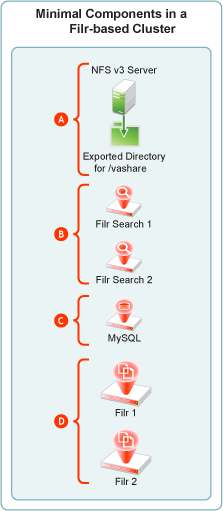4.1 Overview
In Filr management software and in some of the documentation, the term Filr clustering
or simply clustering
is used to indicate that multiple Filr appliances store common configuration settings and data in the same, mutually accessible NFS or CIFS storage location.
Each Filr appliance accesses the storage through a mount point named /vashare. The dialogs used to configure Filr to use shared storage refer to this as clustering.
Shared storage provides fault tolerance and high availability in the sense that, if one Filr appliances goes down for maintenance or other reasons, other Filr appliances have access to the same settings and data, enabling Filr services to continue without interruption.
In this guide we generally refer to Filr-clustered deployments as large, expandable deployments.
When planning a Filr deployment, it is important to keep in mind that deploying Filr as a small or large, non-expandable system prevents expanding the deployment to accommodate organization growth or increased Filr service demands in the future.
Figure 4-1 Components that a Filr Cluster Must Contain

|
Letter |
Details |
|---|---|

|
Exported NFS Directory: All of the Filr appliances in the cluster share this directory to store mutually accessed configuration files, personal storage, temporary files used by upload and conversion processes, and HTML renderings. |

|
Filr Search Appliances: Novell best practices require that each Filr cluster be configured with two Filr Search appliances. |

|
MySQL Appliance: Each Filr appliance in a cluster accesses the same MySQL database. As noted in |

|
Filr Appliances: By definition, a Filr cluster must contain at least two Filr appliances. More appliances can be included as the service load warrants. |